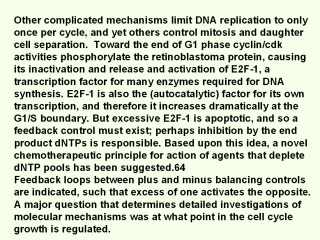 |
The prior
belief was that growth control is exerted at the end of a cycle. In
contrast, two major researches on this question showed it to be exerted in
late G1 phase This process, at about two hours prior to initiation of DNA
synthesis in mammalian cells at, the Restriction (R) Point discovered by
Pardee in 1974.65 Lee Hartwell at this time demonstrated that growth of
cycle-regulating yeast mutants that he isolated is similarly regulated at
“START” in G1.66 R and START are the first demonstrations of what were later
named “checkpoints”. Thus, a wholly different set of events came into
consideration, and it involved molecules soon identified. Numerous
intracellular mechanisms regulate eukaryotic cell cycling. Protein synthesis
is one such essential process.67 Rapid protein synthesis is needed to enter
S-phase, which suggests the requirement for a growth regulating protein with
a short half-life. A sensor for protein synthesis and cell growth is the
kinase mTor; locking its activity with rapamycin stops cells in G1.68 This
led to discovery of control of the R protein by its synthetic vs.
degradation rates. Only one protein (p68) of the many detected on 2-D gels
had three characteristics of R. It increases in G1, has a short half-life,
and is elevated in cancer cells.69 R protein might be cyclin E, one of the
cyclin family of regulatory proteins that are central to cell cycle control.
Several proteins including structural actin also increase after cells enter
their proliferation cycle. |
